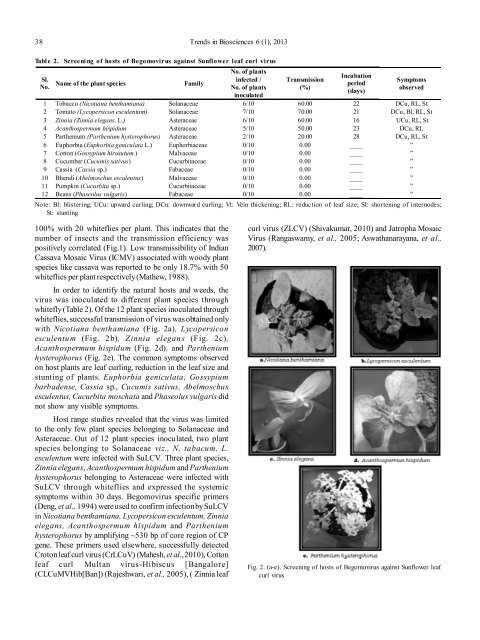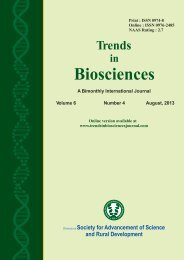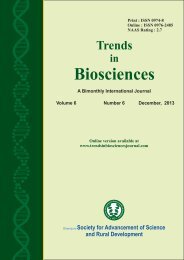TRENDS IN BIOSCIENCES 6-1, 2013 EDITION
CALL FOR RESEARCH PAPERS
CALL FOR RESEARCH PAPERS
Create successful ePaper yourself
Turn your PDF publications into a flip-book with our unique Google optimized e-Paper software.
38 Trends in Biosciences 6 (1), <strong>2013</strong><br />
Tabl e 2. Screeni ng of hosts of Begomovirus against Sunflower leaf curl virus<br />
Sl.<br />
No.<br />
Name of the plant species<br />
Family<br />
No. of plants<br />
infected /<br />
No. of plants<br />
inoculated<br />
Transmission<br />
(%)<br />
Incubation<br />
period<br />
(days)<br />
Symptoms<br />
observed<br />
1 Tobacco (Nicotiana benthamiana) Solanaceae 6/10 60.00 22 DCu, RL, St<br />
2 Tomato (Lycopersicon esculentum) Solanaceae 7/10 70.00 21 DCu, Bl, RL, St<br />
3 Zinnia (Zinnia elegans, L.) Asteraceae 6/10 60.00 16 UCu, RL, St<br />
4 Acanthospermum hispidum Asteraceae 5/10 50.00 23 DCu, RL<br />
5 Parthenium (Parthenium hysterophorus) Asteraceae 2/10 20.00 28 DCu, RL, St<br />
6 Euphorbia (Euphorbia geniculata L.) Euphorbiaceae 0/10 0.00 ____ ”<br />
7 Cotton (Gossypium hirusutum.) Malvaceae 0/10 0.00 ____ ”<br />
8 Cucumber (Cucumis sativus) Cucurbitaceae 0/10 0.00 ____ ”<br />
9 Cassia (Cassia sp.) Fabaceae 0/10 0.00 ____ ”<br />
10 Bhendi (Abelmoschus esculentus) Malvaceae 0/10 0.00 ____ ”<br />
11 Pumpkin (Cucurbita sp.) Cucurbitaceae 0/10 0.00 ____ ”<br />
12 Beans (Phaseolus vulgaris) Fabaceae 0/10 0.00 ____ ”<br />
Note: Bl: blistering; UCu: upward curling; DCu: downward curling; Vt: Vein thickening; RL: reduction of leaf size; SI: shortening of internodes;<br />
St: stunting<br />
100% with 20 whiteflies per plant. This indicates that the<br />
number of insects and the transmission efficiency was<br />
positively correlated (Fig.1). Low transmissibility of Indian<br />
Cassava Mosaic Virus (ICMV) associated with woody plant<br />
species like cassava was reported to be only 18.7% with 50<br />
whiteflies per plant respectively (Mathew, 1988).<br />
In order to identify the natural hosts and weeds, the<br />
virus was inoculated to different plant species through<br />
whitefly (Table 2). Of the 12 plant species inoculated through<br />
whiteflies, successful transmission of virus was obtained only<br />
with Nicotiana benthamiana (Fig. 2a), Lycopersicon<br />
esculentum (Fig. 2b), Zinnia elegans (Fig. 2c),<br />
Acanthospermum hispidum (Fig. 2d), and Parthenium<br />
hysterophorus (Fig. 2e), The common symptoms observed<br />
on host plants are leaf curling, reduction in the leaf size and<br />
stunting of plants. Euphorbia geniculata, Gossypium<br />
barbadense, Cassia sp., Cucumis sativus, Abelmoschus<br />
esculentus, Cucurbita moschata and Phaseolus vulgaris did<br />
not show any visible symptoms.<br />
Host range studies revealed that the virus was limited<br />
to the only few plant species belonging to Solanaceae and<br />
Asteraceae. Out of 12 plant species inoculated, two plant<br />
species belonging to Solanaceae viz., N. tabacum, L.<br />
esculentum were infected with SuLCV. Three plant species,<br />
Zinnia elegans, Acanthospermum hispidum and Parthenium<br />
hysterophorus belonging to Asteraceae were infected with<br />
SuLCV through whiteflies and expressed the systemic<br />
symptoms within 30 days. Begomovirus specific primers<br />
(Deng, et al., 1994) were used to confirm infection by SuLCV<br />
in Nicotiana benthamiana, Lycopersicon esculentum, Zinnia<br />
elegans, Acanthospermum hispidum and Parthenium<br />
hysterophorus by amplifying ~530 bp of core region of CP<br />
gene. These primers used elsewhere, successfully detected<br />
Croton leaf curl virus (CrLCuV) (Mahesh, et al., 2010), Cotton<br />
leaf curl Multan virus-Hibiscus [Bangalore]<br />
(CLCuMVHib[Ban]) (Rajeshwari, et al., 2005), ( Zinnia leaf<br />
curl virus (ZLCV) (Shivakumar, 2010) and Jatropha Mosaic<br />
Virus (Rangaswamy, et al., 2005; Aswathanarayana, et al.,<br />
2007).<br />
Fig. 2. (a-e). Screening of hosts of Begomovirus against Sunflower leaf<br />
curl virus















